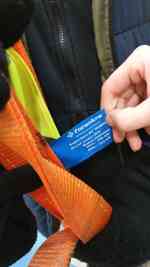Step 1 of 4•3 minutes read
The Strength of Cargo Securing Equipment
Cargo securing onboard is done by using various types of cargo-securing equipment. The most common types are described in this chapter. Both the portable and the fixed cargo securing equipment onboard are to be listed and described in the vessel's cargo securing manual, along with guidance on the amount of equipment to use for different cargoes and instructions on correct assembly, maintenance and scrapping. Furthermore, the manufacturer's certificates for the equipment should be inserted into the manual.
The strength of cargo-securing equipment may be given in several different ways:
- Firstly, the strength can be expressed in different units, such as kN, daN, tons, or kg. These units are related to each other in the following way: 1 ton = 1000 kg = 1000 daN = 10 kN
- Secondly, the stated strength may refer to either the Minimum Break Load (MBL) or the Maximum Securing Load (MSL). Additionally, lashing equipment may be marked with the pre-tension (STF), i.e. the tension one can achieve in the lashing by using its tensioning device.
We will now explain these different types of strengths more closely.

The strength should be marked on the securing equipment but may be expressed in different units
Minimum Break Load (MBL)
The Minimum Break Load (MBL) marking on the cargo securing equipment indicates the tested minimum breaking strain of the equipment in unused condition, also referred to as BL (Break Load).
Web lashings are sometimes manufactured with stripes of thread in contrasting colours, corresponding to the MBL by one ton per stripe. Since there are no norms or regulations governing this, the manufacturer is, however, free to produce lashings with as many stripes as he wishes, regardless of the MBL. The only way to know the breaking strength for certain is to look at the marking label or tag.
Maximum Securing Load (MSL)
Due to wear and tear or uneven quality, equipment may, in practice, break, shred or snap at lesser loads than the MBL and therefore, they may never be subjected to loads that are as great as MBL. The highest load to which cargo securing equipment may safely be subjected is called the Maximum Securing Load (MSL) or, in some cases, the Lashing Capacity (LC).
The marking LC is typically used for lashing equipment intended for use with road vehicles, and that is marked following the European standard EN 12195-2, while MSL is the most common marking for equipment used on vessels.

Maximum securing load expressed as a percentage of the minimum break load according to the CSS Code
MSL is taken as a percentage value of the MBL. The percentage value differs for different materials and depends on the material's ability to withstand wear and tear. The table above, showing the relation between MSL and MBL for different materials, is taken from Annex 13 of the CSS Code.
For example, a chain lashing with an MBL of 15 tons (150 kN) will thus be allowed to be subjected to an MSL of 7.5 tons (75 kN) since the MSL is taken as 50% of the MBL.
Pre-Tension (STF)
Tensioning devices on lashing equipment are designed to produce a certain strain in the lashing. That force is called pre-tension or Standard Tension Force (STF), according to the European standard EN 12195-2.
To determine the STF, the tension handle is pulled with a force of 50 kg, representing normal hand force, and the pre-tension is measured. As a rule of thumb, the pre-tension is typically 10 % of the lashings MBL, but it rarely exceeds 1 ton (10 kN).

Pre-tension is typically 10 % of the lashings MBL, but it rarely exceeds 1 ton (10 kN)